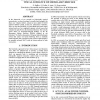Free Online Productivity Tools
i2Speak
i2Symbol
i2OCR
iTex2Img
iWeb2Print
iWeb2Shot
i2Type
iPdf2Split
iPdf2Merge
i2Bopomofo
i2Arabic
i2Style
i2Image
i2PDF
iLatex2Rtf
Sci2ools
112
Voted
ISCAS
2003
IEEE
2003
IEEE
Bio-inspired optical flow circuits for the visual guidance of micro air vehicles
In 1986, Franceschini et al. built an optronic velocity sensor [11], the principle of which was based on the findings they had recently made on fly EMDs by performing electrophysiological recordings on single neurons while concomitantly applying optical microstimuli to single photoreceptor cells [12]. As early as 1989, a battery of 110 velocity sensors of this kind was used to enable a small autonomous mobile robot to steer its way through an unknown field full of obstacles at a relatively high speed (50 cm/s), based on optic flow measurements [1-2]. Later on, several electronic EMDs based on sensors such as the Reichardt correlation sensor [13] or Franceschini et al’s 1986 velocity sensor [14] were developed to serve as smart VLSI circuits. In the framework of our research on biologically inspired microrobotics, we have developed a visually based autopilot for Micro Air Vehicles (MAV), which we have called OCTAVE (Optical altitude Control sysTem for Autonomous VEhicles). Here, we sh...
| Added | 04 Jul 2010 |
| Updated | 04 Jul 2010 |
| Type | Conference |
| Year | 2003 |
| Where | ISCAS |
| Authors | Franck Ruffier, Stéphane Viollet, S. Amic, Nicolas H. Franceschini |
Comments (0)

